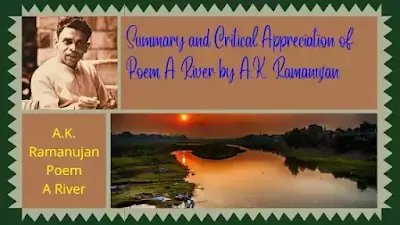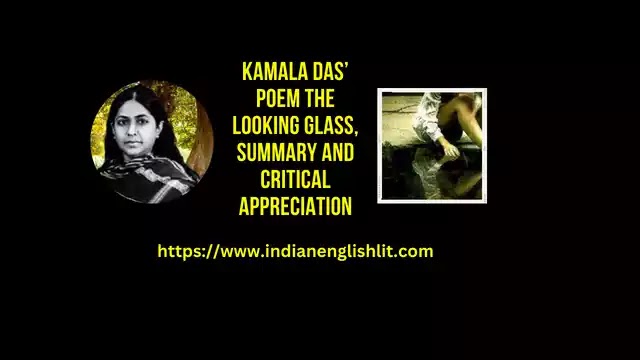Introduction to the Poem:
The poem entitled A River was published in The Striders in 1966. It is a poem on the river Vaikai which flows through Madurai, a city that has for long been the seat of Tamil Culture. The poet clearly reveals the attitudes of both old and new Tamil poets who have shown utter indifference and callousness to human suffering at the time of devastating flood. It is conspicuous for ironic contrasts and good humoured satire at poets who are fond of sensational events such as flood. He also condemns those poets who emphasise only on the outer beauty of nature, ignoring its deeper significance. The poet of this poem is concerned with the human aspect of a situation and highlights the bitter truth in all its shocking harshness. The poet depicts a regular occurrence in many parts of India during monsoons when the rivers are in spate and tend to wash away entire villages a stretch.
Ramanujan's sensibility is Indian. His Western education, his stay in U.S.A. and remoteness from India, have sharpened his sensibility and he conjures up vivid pictures of Indian life from the vast treasure of his memory.
 |
| Summary and Critical Appreciation of Poem A River by A.K. Ramanujan |
Summary of the Poem:
The city of Madurai is famous for its temples and poets. Many poets have written poems in the praise of city and its temples. There is a river - the river Vaikai - which dries up in summer season. It turns into a narrow trickle flowing through mounds of sand appearing like ribs. Its Watergates get blocked with straw and women's hair. The bars of the gates get rusty. The bridge has patches of repair all over it. The wet stones spotting the river look like sleeping crocodiles and shine in the sun and the dry stones look like shaven water buffaloes, relaxing in the sun. Many poets of Madurai sing only the beauty of the flooding river not about the reality of flood destruction or reality of the dry river. They have no least interest in observing the scenes of discomfort. They are not interested in the ugly sides of river whether they are related to the flood or the dried river. They see only the beauty of swollen river during flood and sing this sight in their verse.
A visitor once happened to spend one day in Madurai when a flood in the river was imminent. He actually saw what happened when floods came that year. Flood became the subject of curiosity, fascination and wonder among the people. The people took great interest in seeing the sight of the flood. In the opinion of the visitor, it was the time of crisis because the flood could make great harm and destruction to the villages which were situated near the river. Instead of worrying about the destruction made by the flood, the people everywhere talked about the gradual rising (level) of the flood water. They talked about the water rising over the cobbled steps leading to the river. They saw that the cobbled steps were disappearing one by one and the water was rising over the bathing places. The visitor heard people talking about the flood waters sweeping away three village homes, one pregnant woman and a couple of cows name Gopi and Brinda, but this was not something unusual. Such events were common during flood.
The new poets also followed the tradition of the old poets and sang the verse only about floods. They were highly fascinated towards the beauty and sights of the swollen river. They were not interested in the dark aspects caused by the flood . They ignored the destruction brought by flood. They had no emotions for the distressed humanity. They were very far from the feelings of humanity. They remained in the world of beauty and fancy. The swollen river represented an enchanting sight for them. They did not notice the drowning of the pregnant woman. The drowning of the pregnant woman indicated the loss of two or three lives - woman and one or two children in her womb. When the pregnant woman was drowning, she would have perhaps felt the kicking of one or two children against the walls of her womb. It seemed as if the child or children were asking to be released from the womb of the woman. Perhaps the poets did not want to imagine this state of the drowning woman. They were able to imagine something which was beautiful, but their imagination stopped working when it was the matter of tragic event.
He (the poet or the visitor) who had been in the city for a day, opined that the river had enough water to be poetic, i.e., to invoke poetic praise only (for a very short time) once a year. The flood carried away three village houses, couple of cow's named Gopi and Brinda and a pregnant woman in very first half hour. Perhaps the pregnant woman was expecting identical twins having no moles on their bodies and therefore, with nothing to enable anybody to differentiate between them after their birth. In other words, the t ins in the womb were identical, and had no moles or different coloured diapers on their bodies to distinguish one from the other. They died even before their birth. They could not come out in this inhuman, selfish and merciless world, though they tried their best to come out from the womb of their mother by kicking against the walls of womb but they remained failure. As their mother's breath stopped, they also died.
Critical Appreciation of the Poem:
Introduction:
The poem entitled A River is one of the finest poems that appeared in The Striders in 1966. The poem is an evocation of river, but it clearly reveals the attitudes of both old and new Tamil poets who have shown utter indifference and callousness to human sufferings at the time of devastating flood. They only glorify the beautiful aspects of over-flooded river and ignore the tragic aspects of human suffering and miseries caused by the flood. They never try to make any practical treatment about the tragic aspects in their poems. They think that by pouring the tragic and dark side of human life into their poems, the beauty and sweetness of their poems may be marred. In the poem, the poet also describes the tendency of the worldly people who, instead of thinking of human welfare and helping the flood victims, get excitedly engrossed in the activities of flood and as spectators, they are curious to talk over the situation of flood. They only see the rising water level, but are not interested in the loss caused by flood.
Thought - Content:
In the poem, the poet depicts a river which flows through the city Madurai. Next he describes the poets living in city. The poets of this city like to glorify the beauty of the over-flooded river during monsoon. But they ignore tragic aspects of human life caused by the flood. The poet observes the common people who talk about the level of the water rising quickly. They talk about the water rising over the steps leading to the river. They also talk about the flood waters sweeping away the village houses, pregnant woman and cows.
The Use of Irony:
The poem is not so much about a river as about the attitude of some people who favour sensationalism over humanism. The poet uses irony to reveal the indifferent attitude of old and new poets towards human sufferings, miseries and immense loss caused by the flood. There is great want of human concern in the old and new poetry. The poet satirizes the poets for choosing petty matter as the theme of their poetry. The poet condemns them for concealing the reality of human life. How ironically the devastating power of the river is described.
The Use of Humour:
Although this poem is replete with serious incidents, yet we find humorous touches in it. We are amused when we notice the watergates of the river being choked with women's hair and the cows being named Gopi and Brinda. The child's or children's kicking at the blank walls of the mother's womb, asking to be released to live in this world also makes humorous impact:
“straw and women's hair
clogging the watergates
at the rusty bars.”
“...… of the pregnant woman
drowned, with perhaps twins in her,
kicking at blank walls
even before birth. "
The Use of Imagery:
The concrete imagery makes the poem quite realistic and interesting. The imagery is suggestive and picturesque. The cameo - like picture of the dried up river reveals a poetic eye for minute details. The dryness of the river, described in the following lines , also suggests the emotional sterility and want of human concern of poets :
“a river dries to a trickle
in the sand,
baring the sand - ribs,
straw and women's hair
clogging the watergates
at the rusty bars. "
The Use of Figure of Speech:
The poet has used the figure of speech simile to add the charm of the poem. He has compared the wet stones with the sleepy crocodiles. The dry stones have been compared with water buffaloes relaxing in the sun:






